
Features
Crops
Flowers
Growing in the Green: Celebrating ‘Year of the Petunia’
March 10, 2014 By Melhem Sawaya
Petunia is one of the most popular genera of the floriculture industry.
Petunia is one of the most popular genera of the floriculture industry. Its only drawback is that it is so beautiful and proud of itself that it never wants to hide in the shade!
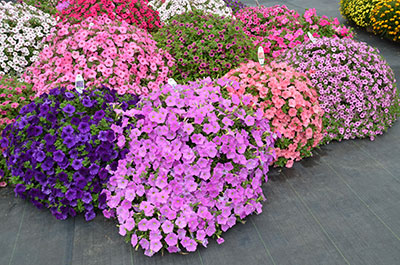 |
|
| A sampling of colourful trailing petunia varieties Advertisement
|
Petunia loves the sun, the heat, and has a large appetite for food. In return, petunia gives the ultimate flowering garden plant performance.
How successful is it for consumers? The National Garden Bureau has proclaimed 2014 as the Year Of The Petunia! That endorsement should help boost sales considerably for growers and retailers incorporating it in their marketing efforts.
Flower induction: Most petunias are day neutral and they flower by light accumulation. The brighter the days, the less time it takes to flower. Some varieties, such as the original Purple Wave, flower faster under long days so night interruption helps.
CULTURAL REQUIREMENTS
Light: Petunias love high light levels. Glass greenhouses produce much better quality petunias than do plastic ones. However, the best conditions are cool temperatures with high light levels. This will result in many buds and compact growth without any chemical growth regulators.
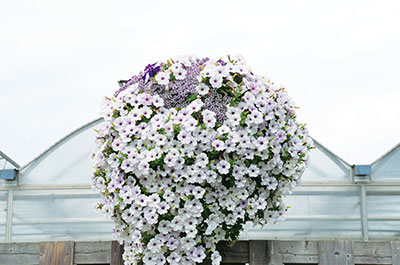 |
|
| Petunias work well in most combinations, adding much to their consumer value |
|
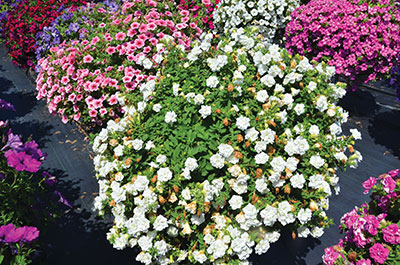 |
|
| Double petunia after a heavy rain.
|
An economical way to produce early flowering plants is to grow large plugs or liners under high intensity lights. When they are transplanted it will be longer days and most likely higher light levels.
Temperature: Petunias will flower faster under high temperatures. However, if the light levels are not high, you’ll find the plant quality is inferior under low light and high temperatures. That is why petunia flourishes outdoors in the summer with the high light levels and high temperatures, but only as long as we are watering and fertilizing continuously.
Nutrition: Petunias, and especially the vegetative trailing varieties, are very heavy feeders, especially in hot sunny weather. A continuous fertilization program is a must.
Petunias like lower pH levels of 5.5 to 5.7. Fertilizing with acidic fertilizer helps a great deal, especially if your raw water has a high pH.
In our studies at the Sawaya Garden Trials near Simcoe, Ontario, the water pH is 7.5 with bicarbonates close to 300. We fertilize with 18-9-18, an acidic fertilizer with a higher level of iron, and the combination keeps the petunias healthy and green – even with our much less than optimum water – as long as we continuously fertilize.
Water: Petunias do not like continuously wet feet, because this will lead to iron deficiency. At the same time, wilting the plant will lead to yellow leaves.
PRODUCTION ISSUES
Propagation: Seed propagation requires a temperature of 23-24 C without covering the seed. The media should be moist in Stage 1 before quickly easing off the water. Work with the root media rather than the top of the media to encourage root development.
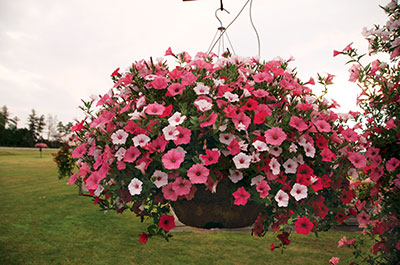 |
|
| Excellent multiflora trailing petunias; |
|
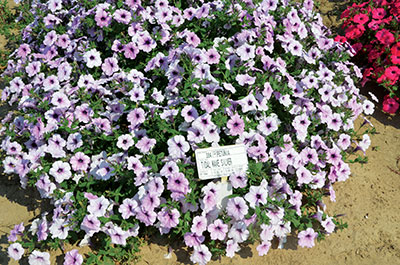 |
|
| Hedge petunia is great for landscapes | |
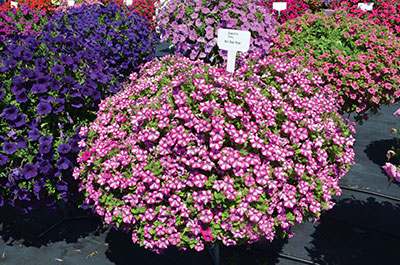 |
|
| Mini Blast Rose’ is a strong performer
|
Fertilize on Day 10 with an EC of 1, then increase EC to 1.2 at Stages 4 and 5. With vegetative propagation, a temperature of 23-24 C is a must with enough moisture to get the leaves turgid. This is followed by a quick easing of the water and you can start to fertilize on Day 7 with an EC of 1 that can then be increased to 1.2.
Medium: Since petunias do not like wet feet, media that has good air porosity is a must. Petunias like a pH of 5.5 to 5.7, so beginning with media that starts with pH of 5.5 works well. It keeps your plants green and the roots will get established much faster.
Planting: Fertilize the liners just before planting. This will help the liner/plug roots spread into the planting media much easier because it will have lower EC levels.
Do not bury the growing tip of the cuttings or the leaves. Planting into moist media will make planting much easier because the soil level is more defined when it is wet.
Pinching: Petunia plugs do not require any pinching. Almost all varieties are self-branching and pinching will delay the first set of buds. Pinching is only needed if the hanging baskets get out of control. With proper timing, culture and chemical growth regulators, pinching is an added cost. Production procedures should be adjusted to eliminate pinching .
Spacing: Spacing varies depending on the variety, type of greenhouse and the density of the crop above if the petunias are grown under hanging baskets.
As a general rule, the branches of one pot should not overlap the next pot.
Growth regulators: There many cultural practices that can affect petunia growth, including:
- Timing, which is the most important and the most economical factor.
- Variety selection for the pot size.
- Number of plants per pot.
- Temperature – delivery and average.
- Watering.
- Humidity.
- Light.
- Plant canopy.
- Fertilizer type.
- Pinching (which is not economical, as noted earlier.)
- Chemical growth regulators.
- Ethrel (florel).
- B-Nine.
- Bonzi.
- Sumagic.
The rates of the chemical growth regulators vary so much by greenhouse environment, personal practices and timing that it makes it dangerous to follow one rate. You can e-mail your questions and I will be happy to answer you.
SEED PROPAGATED VARIETIES
Petunia comes in many different categories.
Double flower grandiflora: The large double flowers need high light energy to flower. They look great … until it rains, and then the flowers can turn to mush.
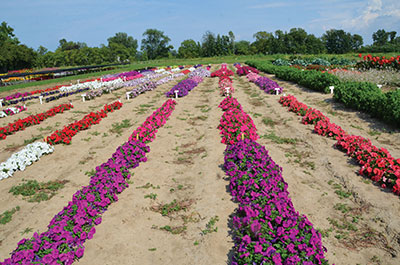 |
|
| Trials are great for selecting your next market winner |
|
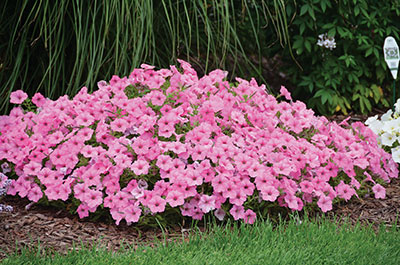 |
|
| Trailing petunias work well in any landscape | |
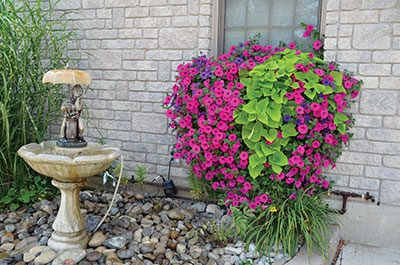 |
|
| Want your customers to enjoy even better gardening success? Recommend they install a drip system!
|
Single flower grandiflora: The single grandiflora petunia flowers easily with large single flowers, but the rain will make them look like they came out of a heavy duty washing cycle.
Double flower multiflora: As the name indicates, it has more flowers than the grandiflora but they are smaller. It flowers easier and earlier in the season than the grandiflora and recovers from the rain much better.
Single flower multiflora: It has lots of single flowers. It flowers early season and recovers well after a rain.
Double flower milliflora: It features loads of flowers on small plants. It often does not perform very well in less than optimal weather conditions.
Single flower milliflora: It is full of flowers, but often to the point you do not see the plant. This often means the flower ratio is so much more than the plant growth, and this forces the plant to underperform. It is a group that is cute for a short time.
Trailing petunias: This petunia performs better than any other type. Leading all trailing petunias, in my opinion, is Purple Wave. New genetics have seen trailing varieties crossed with the upright ones to get a whole series of excellent performing varieties.
Mounding: This is the cross between many new trailing and new upright varieties to select for mounding types. Mounding petunias are easier for shipping and feature good quality.
VEGETATIVELY PROPAGATED VARIETIES
Vegetatively propagated varieties consist of all the seed categories but propagated by cuttings to stay true to the parents. Normally they are more vigorous and tolerant to rain, heat and resistant to Botrytis.
The more the plant has a trailing habit, the better its garden performance. Surfinia is a great vegetative petunia.
PROBLEMS
Among diseases, powdery mildew is a threat. Botrytis can also be a problem, especially on the upright varieties if water gets on the flowers.
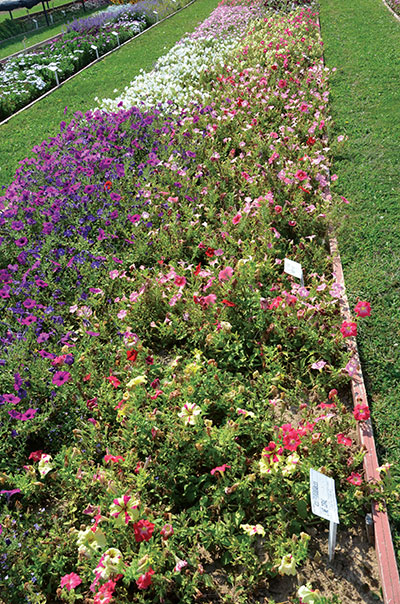
|
|
| Botrytis took over these upright petunias.
|
In our trials last year, all seed upright varieties did not make it past August while the trailing varieties survived until after frost.
Insects to watch for include spider mites, thrips and aphids, and there are some virus issues.
Watch for hardened growing tips if you have high EC problems with fertilizers that include phosphorus.
SCHEDULING
With 4” production (one plant), it will take five weeks to finish. With 6” pots (one plant), it will take seven weeks to finish. With 10” pot sizes (three plants), it will take seven to eight weeks to finish.
MARKET IMPORTANCE
Petunia is the number one bedding plant, especially in light of the impatiens downy mildew situation. It is great in landscapes, pots, large patio containers and hanging baskets.
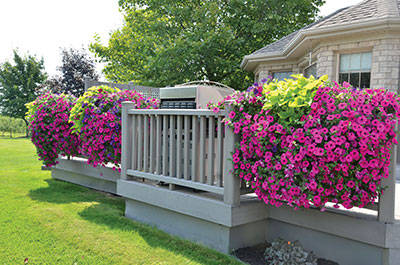 |
|
| Window boxes on a patio railing;
|
It works well in almost every combination due to its diverse habit and range of colours.
The best type of petunia in our trials is the vegetative single multiflora that recovers fast from the rain, requires no deadheading, and features loads of flowers.
EDITOR’S NOTE: Melhem Sawaya returns as moderator at this year’s Greenhouse Canada Grower Day, being held June 18 in Brantford. For more information, visit the Grower Day microsite at www.greenhousecanada.com/grower-day.
Melhem Sawaya of Focus Greenhouse Management is a consultant and research coordinator to the horticultural industry. Comments on this or any other article are welcome at mel@focusgreenhousemanagement.com.
Print this page